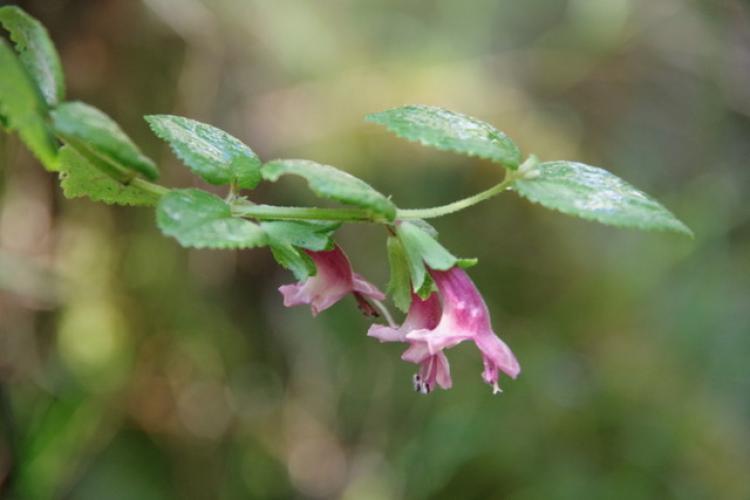Hawaii’s mysterious mints, discovered then ignored, get a fresh look
CU Boulder grad student’s work deepens understanding of evolution and extinction
In the late 1980s, just as another group of scholars was preparing a 2,500-page, two-volume text cataloging the unique flora of the Hawaiian Islands, Harold St. John, once a pioneering professor of botany, long-time chair of the Botany Department and director of the arboretum at the University of Hawai’i at Mānoa from 1929 to 1958, then in his 90s, published 37 articles describing 894 new plant species in the islands, an almost unprecedented number, including 157 new species of mint.
Under the international code of scientific nomenclature, first publication takes priority. But the researchers on the other project found some small errors in his work, and the scientific community dismissed and then ignored St. John’s prodigious work.

Above is a species of mint identified by Justin Williams as Stenogyne sessilis. At the top of the page, Mitchell examines Stenogyne macrantha. Photos courtesy of Justin Williams.
“People wrote him off. They just thought he was this old guy who’d done sloppy work,” says Justin Williams, a graduate student in museum and field studies at the University of Colorado Boulder Natural History Museum. Williams suggests that St. John’s few errors might have been due to his intentionally rushing to press in the race for publication priority.
Flash forward three decades. Botany has been revolutionized by molecular DNA work, which has led researchers to re-examine and, in many cases, rewrite, long-held taxonomies for Hawai’ian flora. And Williams’s own research on mints in the Hawaiian Islands has led him to a surprising revelation: “Preliminary data is suggesting that Harold St. John was onto something.”
But that’s just one wrinkle in Williams’ gradual unraveling of mysteries surrounding Hawai’i’s mint species. They are true mints, but like so much of the islands’ flora and fauna, they are quite distinct from their generic continental relatives you might pluck from your garden for iced tea or other continental species.
For one thing, they don’t have that familiar minty odor. Rather than evolving into trees like Hawai’ian violets and lobeliads, they are either dainty herbs or enormous woody vines. And unlike any other mint, they produce fleshy fruits.
“Hawaiian mints seem to be an oddball when we evaluate them under traditional … evolution theory,” says Williams, who has been working with two of the 157 species described by St. John, courtesy of the botany department at the world-famous Bishop Museum.
“Preliminary molecular results strongly support that these two specimens are unique taxa, supporting St. John’s species hypothesis and refuting previous claims that his work was rushed and sloppy.”
Williams’ molecular sleuthing indicates that while Hawaiian mints likely came to the islands from North America, some 2,500 miles away, they later dispersed more than 3,500 miles to the island of Tonga, unusual for a species that evolved fleshy fruit—which sinks, rather than floats, in seawater, a factor that has limited long-distance dispersal of several other Hawaiian species.
The mints also seem to violate Hennig’s “progression rule” in evolution, which states that the most primitive species of any group will be found in the earliest, most central location.
Finally, the currents and prevailing winds don’t support the case for “extra-Hawaiian dispersal,” but that’s what the DNA says.
These mints have the potential to redefine how we think of insular evolution, as well as regular evolution and the speciation and extinction process,”
“These mints have the potential to redefine how we think of insular evolution, as well as regular evolution and the speciation and extinction process,” Williams says.
Of the currently parsed 59 mint species, all but two are found in Hawai’i. The other two, only found on that islands of Tahiti and Tonga, were first collected in the late 1800s. Williams notes that the Tongan species was collected only once, in 1958 … by Harold St. John.
The mysteries surrounding St. John and Hawaiian mint species fascinate Williams. But he hopes his systematics research—properly describing and placing species on the taxonomic tree—will have a real-world impact for the islands known as “the endangered species capital of the world,” where two-thirds of species are considered threatened, endangered or even extinct.
“Refining our systematic understanding of what the species are will inform immediate conservation action, but also provide a foundation from which to answer interesting evolutionary and ecological questions,” Williams says. He hopes that persistent fieldwork will lead to the rediscovery of species thought to be extinct, as well as new populations of rare and endangered plants.
“In a time of mass global extinction, any efforts to refine our knowledge of these processes, especially that of extinction, could significantly contribute to us reversing that trend,” Williams says.

